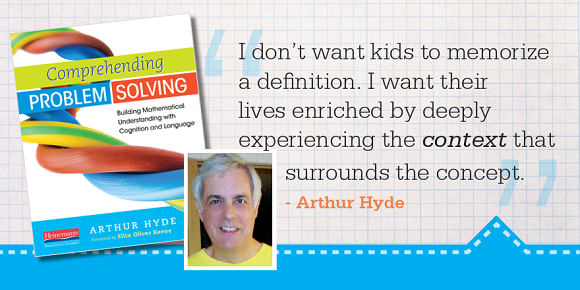In his new book, Comprehending Problem Solving, Arthur Hyde discusses how linking language and math can help students develop a deeper, richer understanding of mathematical concepts. In today’s blog, which is one of the classroom stories from Comprehending Problem Solving, second grade teacher Amy Tepavchevich reflects on guiding her young students to stretch from “think-pair-share” to more sophisticated math conversations as a class.
In his new book, Comprehending Problem Solving, Arthur Hyde discusses how linking language and math can help students develop a deeper, richer understanding of mathematical concepts. In today’s blog, which is one of the classroom stories from Comprehending Problem Solving, second grade teacher Amy Tepavchevich reflects on guiding her young students to stretch from “think-pair-share” to more sophisticated math conversations as a class.

Talking Math in the Classroom
By Amy Tepavchevich
Having come from an intermediate grade to a primary grade, I was skeptical about how math talks would look or work in my classroom. We spent our days practicing sitting in our seats and not asking what time recess was; how was I going to hand over control and let the students guide their math discussions? I accepted that our math talks in second grade would look different from some of the examples I knew, but I was sure students could participate in meaningful discussion. It was just a question of how to get started.
I started simply. We were reviewing how to make 10, a concept my students had worked on in first grade. I began with partner discussions, being very careful to pair students wisely to ensure productive conversations. I posed a math problem on the board, 7 + 6 = and asked students to turn to their partners and brainstorm how they might go about solving this problem.
After a few minutes, we reconvened as a class. “OK, what were some strategies you used?” I was bombarded with hands. “I counted on,” “I did 6 + 6 = 12 and added 1.” But this was still the traditional classroom response: Raise your hand and wait to be called on. I decided to build on the think-pair-share idea. I placed a new problem on the board and asked students to turn to their partner and talk about it, but I stopped them before they began. “What does a conversation sound like? How many people are talking at one time?” We talked about respecting the person one is talking to, not talking over each other, making eye contact, and asking questions to gain more understanding. Then I let them think through the problem with their partner. They each had a piece of blank paper, and I asked them to show the thinking they had done as they worked to find a solution. Noise escalated as partners decided on a reasonable method, created an explanation on their paper, and verified that each partner knew how they were solving the problem.
This seemed a solid foundation for a math talk. I reconvened the class, partners sitting next to each other, and asked for volunteers to share their thinking. As students explained the math problem on the board, I asked questions for clarification: “How did you decide on that strategy?” “Why did you do that?” “Can you explain that again? I’m confused.” My questions got them talking about their thinking, prompting them to find different ways to explain their answers. As students continued sharing their strategies, I whispered questions in other students’ ears, which the students then asked aloud.
---
My students love math because they are encouraged to talk to one another—a lot.
---
This went on for a few weeks—the students solved a math problem in small groups or with a partner, the class reconvened and students shared their thinking on the board, I walked around and whispered questions in students’ ears. The day students began to raise their hand on their own was a great day! Now all I had to do was label this question-and-answer discussion. I said the words math talk. “It’s similar to what we have been doing,” I explained, “but with more talking.” This got the class’ attention. I was encouraging them to talk without having to raise their hand.
We brainstormed possible questions to ask. What strategies are you using? How did you know that? Where did that answer come from? Why did you choose that method/strategy? Can you describe how you solved this problem another way? How did you check your work to make sure your answer was correct? The students recalled all the questions I had whispered in their ears over the past few weeks and formed a few new ones on their own. I typed up all the questions and gave each student a copy.
Again, we started small. They still solved a problem with a partner but then shared their thinking in a group of four or six students. Each student had a dry-erase board showing their math work and the list of questions to guide their discussions. Students shared their answers with the other members of their small group, who asked questions to clarify their understanding. I listened in, periodically posing a question of my own, occasionally asking whether another student could explain what the first student had just said in another way. During a discussion about double-digit addition strategies, one student asked me, “Can we do it that way? Because I get it like that.” I thought, Great! Math talks can work in my primary setting. But I just said yes.
After a few weeks of practicing math talks in small groups, we began having them as a whole class. When you walk into my room during a math lesson today, the students are talking (without raising their hand), questioning one another, looking to their peers for help, and learning not just from me but from one another. My students love math because they are encouraged to talk to one another—a lot.
Click here to read a sample chapter from Comprehending Problem Solving.


